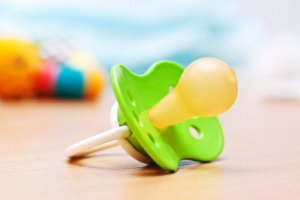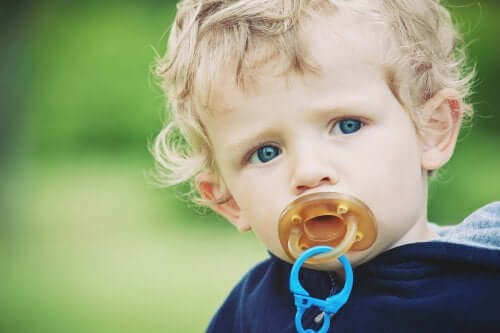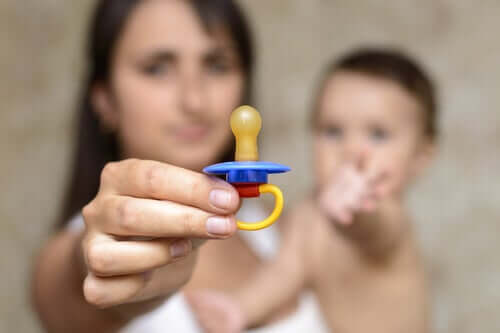Using a Pacifier: Benefits and Concerns

Yes or no to using a pacifier: that’s the question we’ll be answering today. Keep reading to find out about some of the common benefits and concerns about pacifier use in babies.
Possible arguments about using a pacifier
It’s clear that babies have a strong sucking reflex, and some of them even suck their fingers before they’re born. In fact, this seems to calm them down. Needless to say, when babies are calm, parents are too. Therefore, lots of parents love using pacifiers.
However, since sometimes it can interfere with breastfeeding, we don’t recommend using a pacifier while in this stage of motherhood.

Using a pacifier: benefits and concerns
- Pacifiers can be a source of calmness for both babies and their parents.
- Pacifiers can be useful for bedtime when babies are colicky and restless.
- It’s easier to break the habit, unlike trying to get babies to stop sucking their thumb.
Important data about pacifier use
Some evidence shows that using a pacifier reduces the risk of Sudden Infant Death Syndrome (SIDS). Therefore, this is a very important point to keep in mind.
However, other people think it’s not good to use pacifiers because it can interfere with breastfeeding. Therefore, experts often tell us to not use a pacifier until you’re done breastfeeding.
The Spanish Association of Pediatrics Breastfeeding Committee says:
- “While breastfeeding newborns, it’s best not to use pacifiers in the first few days of life. Also, it’s best not to use it until you have an established breastfeeding routine, usually around one month. Then, the risk of Sudden Infant Death Syndrome is higher.”
- “In neonatal units, for painful procedures, if a baby can’t breastfeed, you should offer a pacifier as a non-medicinal painkiller.”
- “To prevent adverse effects, only use a pacifier until the baby is one year old. That is when the risk of SIDS is highest and when babies need something to suck the most.”
In addition, they also state that they need to do more research on the connection between breastfeeding, pacifiers and SIDS. Meanwhile, professionals should continue to tell parents about the benefits of breastfeeding. Additionally, they should tell parents how to prevent exposing their babies to the risk factors of SIDS.

When babies use pacifiers for too long
According to the Spanish Society of Pediatrics Dentistry, “Non-nutritive sucking can cause the lower central teeth to gradually move forward. Also, teeth in the upper jaw tend to separate and protrude outward (buck teeth). In addition, sucking uses face muscles that, along with the position of the tongue, can make the upper and lower rows of teeth not parallel anymore.”
Summary
- It’s important to clarify some myths and truths about using a pacifier.
- Once you know them, figure out the best pacifier for your baby, and use it safely.
Conclusion
According to the Argentine Society of Pediatrics, “Consider using a pacifier once your baby regains his birthweight. Also, when you have no difficulty breastfeeding if your baby is exclusively breastfed. Don’t insist if your baby rejects the pacifier. Finally, don’t put sugary substances like honey on your baby’s pacifier.”
Yes or no to using a pacifier: that’s the question we’ll be answering today. Keep reading to find out about some of the common benefits and concerns about pacifier use in babies.
Possible arguments about using a pacifier
It’s clear that babies have a strong sucking reflex, and some of them even suck their fingers before they’re born. In fact, this seems to calm them down. Needless to say, when babies are calm, parents are too. Therefore, lots of parents love using pacifiers.
However, since sometimes it can interfere with breastfeeding, we don’t recommend using a pacifier while in this stage of motherhood.

Using a pacifier: benefits and concerns
- Pacifiers can be a source of calmness for both babies and their parents.
- Pacifiers can be useful for bedtime when babies are colicky and restless.
- It’s easier to break the habit, unlike trying to get babies to stop sucking their thumb.
Important data about pacifier use
Some evidence shows that using a pacifier reduces the risk of Sudden Infant Death Syndrome (SIDS). Therefore, this is a very important point to keep in mind.
However, other people think it’s not good to use pacifiers because it can interfere with breastfeeding. Therefore, experts often tell us to not use a pacifier until you’re done breastfeeding.
The Spanish Association of Pediatrics Breastfeeding Committee says:
- “While breastfeeding newborns, it’s best not to use pacifiers in the first few days of life. Also, it’s best not to use it until you have an established breastfeeding routine, usually around one month. Then, the risk of Sudden Infant Death Syndrome is higher.”
- “In neonatal units, for painful procedures, if a baby can’t breastfeed, you should offer a pacifier as a non-medicinal painkiller.”
- “To prevent adverse effects, only use a pacifier until the baby is one year old. That is when the risk of SIDS is highest and when babies need something to suck the most.”
In addition, they also state that they need to do more research on the connection between breastfeeding, pacifiers and SIDS. Meanwhile, professionals should continue to tell parents about the benefits of breastfeeding. Additionally, they should tell parents how to prevent exposing their babies to the risk factors of SIDS.

When babies use pacifiers for too long
According to the Spanish Society of Pediatrics Dentistry, “Non-nutritive sucking can cause the lower central teeth to gradually move forward. Also, teeth in the upper jaw tend to separate and protrude outward (buck teeth). In addition, sucking uses face muscles that, along with the position of the tongue, can make the upper and lower rows of teeth not parallel anymore.”
Summary
- It’s important to clarify some myths and truths about using a pacifier.
- Once you know them, figure out the best pacifier for your baby, and use it safely.
Conclusion
According to the Argentine Society of Pediatrics, “Consider using a pacifier once your baby regains his birthweight. Also, when you have no difficulty breastfeeding if your baby is exclusively breastfed. Don’t insist if your baby rejects the pacifier. Finally, don’t put sugary substances like honey on your baby’s pacifier.”
All cited sources were thoroughly reviewed by our team to ensure their quality, reliability, currency, and validity. The bibliography of this article was considered reliable and of academic or scientific accuracy.
- Asociación Española de Pediatría.
- Sociedad Española de Odontología Pediátrica.
- Sociedad Argentina de Pediatría.
This text is provided for informational purposes only and does not replace consultation with a professional. If in doubt, consult your specialist.








